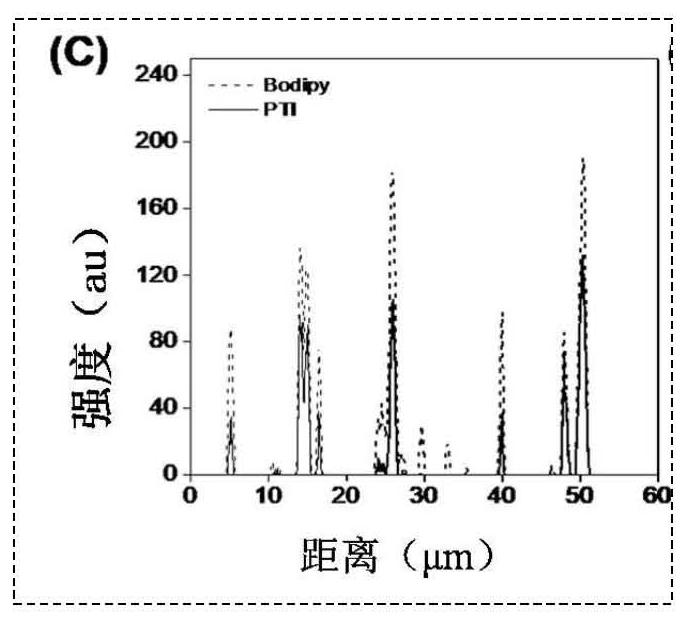Singlet oxygen type photosensitizer material with aggregation-induced emission property as well as preparation method and application of singlet oxygen type photosensitizer material
A technology of aggregation-induced luminescence and singlet oxygen, which is applied in the field of biomedical materials, can solve problems such as unfavorable fluorescence-mediated photodynamic therapy, and achieve the effects of high-efficiency cure, good lethality, and high-specific targeting.
- Summary
- Abstract
- Description
- Claims
- Application Information
AI Technical Summary
Problems solved by technology
Method used
Image
Examples
Embodiment 1
[0056] Example 1 Preparation of a singlet oxygen photosensitizer material (singlet oxygen photosensitizer, marked as PTI in Example 1) with aggregation-induced luminescent properties
[0057]
[0058] The synthetic route is as follows:
[0059]
[0060] a) Synthetic compound 10-phenyl-10H-phenothiazine (1): add phenothiazine (6g, 30mmol), copper powder (1.9g, 30mmol), potassium carbonate (8.3g, 60mmol) in a 100ml two-necked bottle ) and 18-crown-6 (3g, 60mmol), nitrogen-pump-nitrogen cycle 3 times (10 minutes each time), then add iodobenzene 3.93ml and ultra-dry N,N-dimethylformamide 60mL , heated to 180 ° C for 12 hours, the reaction was completed, extracted with dichloromethane / water, dried over anhydrous magnesium sulfate for 2 hours, separated and purified by column chromatography to obtain colorless crystals (4.2g), and the yield was 60%. 1 H NMR (500MHz, CDCl 3 ), 7.60(t,2H), 7.46(t,1H), 7.38(d,2H), 7.01(d,2H), 6.82(m,4H), 6.20(d,2H).
[0061] b) Synthesis of 3-...
Embodiment 2
[0064] Example 2 Preparation of a singlet oxygen-type photosensitizer material (singlet oxygen photosensitizer, marked as PI in Example 2) with aggregation-induced luminescent properties
[0065]
[0066] The synthetic route is as follows:
[0067]
[0068] a) The synthesis steps of the intermediate 10-phenyl-10H-phenothiazine (1) are the same as in Example 1.
[0069] b) Synthesis of compound 10-phenyl-10H-phenothiazine-3-aldehyde (2): Add ultra-dry N,N-dimethylformamide solvent ( 2.8 mL) and 1,2-dichloroethane (5 mL), and after stirring for ten minutes, phosphorus oxychloride (2.1 mL) was added dropwise into the mixture. Then 10-phenyl-10H-phenothiazine (1 g, 3.6 mmol) dissolved in 5 mL of 1,2-dichloroethane solution was added dropwise within 30 min, heated to 90° C., and continued to react for 12 h. After stopping the reaction and cooling to room temperature, the mixture was poured into 100 mL of ice water and washed with saturated NaHCO 3 The solution was neutrali...
Embodiment 3
[0071] Example 3 Based on the specific targeting of lipid droplets by phenothiazine photosensitizers (PI and PTI), after culturing MCF-7 cells for 24 hours, the cells were first incubated with oleic acid for 1 hour, and then 10 μM PI and PTI were added respectively The cells were incubated for 6 hours, then the original medium was removed and washed twice with PBS, and fresh medium containing the lipid droplet dye Bodipy (final concentration 2 μM) was added to continue incubation for 20-30 minutes. After washing and replacing the fresh medium, confocal microscopy imaging was performed. Figure 1a and Figure 1b After the PTI prepared in Example 1 and the PI prepared in Example 2 were incubated with the cells for 6 hours, respectively, the effects of cell lipid droplet staining were performed with the lipid droplet dye BODIPY. Figure 1c and Figure 1d After the PTI prepared in Example 1 and the PI prepared in Example 2 were incubated with the cells for 6 hours, the co-staining...
PUM
 Login to View More
Login to View More Abstract
Description
Claims
Application Information
 Login to View More
Login to View More - R&D
- Intellectual Property
- Life Sciences
- Materials
- Tech Scout
- Unparalleled Data Quality
- Higher Quality Content
- 60% Fewer Hallucinations
Browse by: Latest US Patents, China's latest patents, Technical Efficacy Thesaurus, Application Domain, Technology Topic, Popular Technical Reports.
© 2025 PatSnap. All rights reserved.Legal|Privacy policy|Modern Slavery Act Transparency Statement|Sitemap|About US| Contact US: help@patsnap.com



